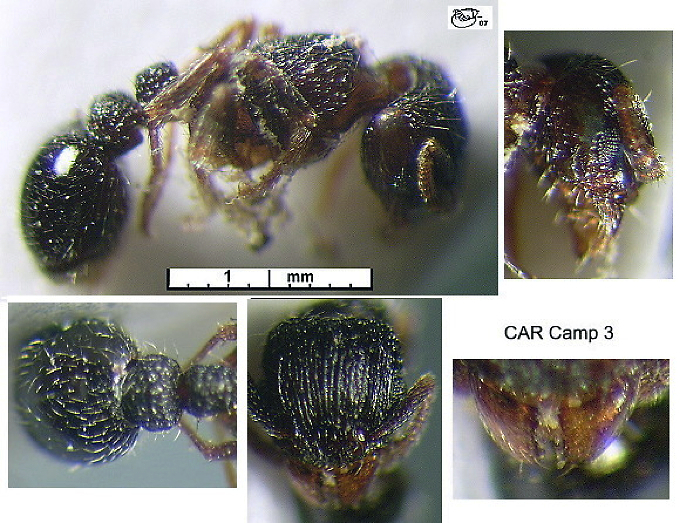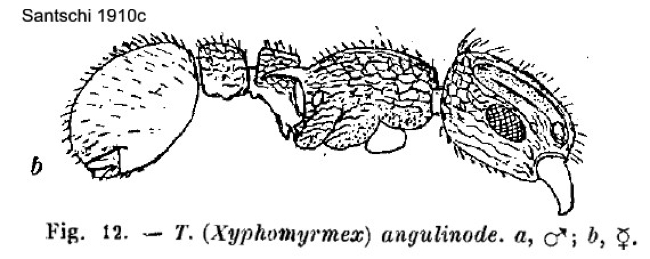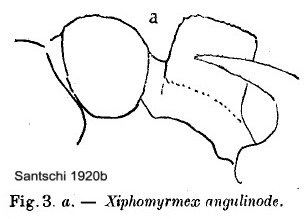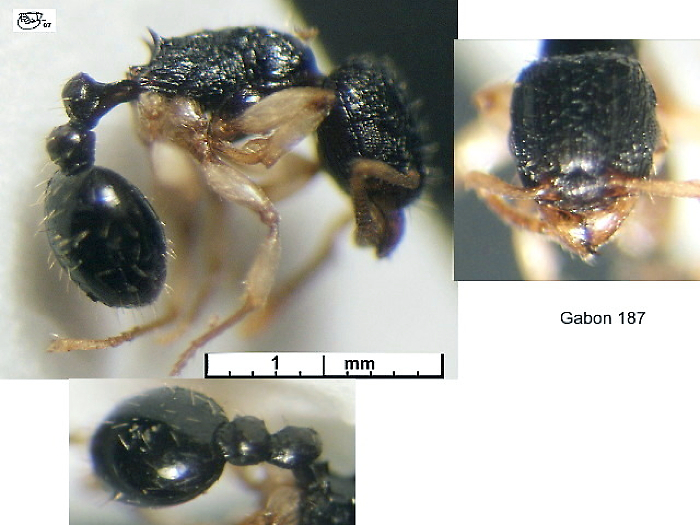Tetramorium angulinode Santschi
 Type location Congo (Tetramorium (Xyphomyrmex)
angulinode, Santschi, 1910c: 385, illustrated, all forms)
collected at Brazzaville, by A. Weiss; junior synonyms daphnis
(Xiphomyrmex angulinode Sants v Daphnis n.
var, Santschi, 1920b: 16, illustrated, worker & queen) from
Zimbabwe, humerosum (Tetramorium humerosum,
Emery, in litteris, Bernard, 1952: 13, illustrated, worker
& queen) from Cameroun, collector L. Conradt, 1895,
and papyri (Xiphomyrmex papyri, Weber, 1943c: 374,
illustrated, queen) from Sudan (see Bolton, 1995)
Type location Congo (Tetramorium (Xyphomyrmex)
angulinode, Santschi, 1910c: 385, illustrated, all forms)
collected at Brazzaville, by A. Weiss; junior synonyms daphnis
(Xiphomyrmex angulinode Sants v Daphnis n.
var, Santschi, 1920b: 16, illustrated, worker & queen) from
Zimbabwe, humerosum (Tetramorium humerosum,
Emery, in litteris, Bernard, 1952: 13, illustrated, worker
& queen) from Cameroun, collector L. Conradt, 1895,
and papyri (Xiphomyrmex papyri, Weber, 1943c: 374,
illustrated, queen) from Sudan (see Bolton, 1995)
 . .
Santschi's (1910c) description is at
 and
and  . Santschi's (1920d) description of daphnis is at
. Santschi's (1920d) description of daphnis is at
 .
Arnold (1926: 279) gave a translation of daphnis, this is
at .
Arnold (1926: 279) gave a translation of daphnis, this is
at  .
Weber's (1943c) description of papyri is at .
Weber's (1943c) description of papyri is at
 .
Bernard's (1952) description of humerosum is at .
Bernard's (1952) description of humerosum is at
 - this Bolton pointed out largely describes a specimen of ataxium,
whereas the type specimens were what Bolton decided was angulinode.
Bolton's modern description (1980) is at
- this Bolton pointed out largely describes a specimen of ataxium,
whereas the type specimens were what Bolton decided was angulinode.
Bolton's modern description (1980) is at
 . .
Fresh specimens, as shown below and on the linked pages,
indicate that Bolton's blanket treatment, characteristic of his
approach to the descriptions of the pioneer taxonomists, was
erroneous.
The answer may lie in Santschi's style of designating varieties
and "stirps" rather than new species for forms with
somewhat similar overall morphology. The illustrations from
Santschi (1920b) are good examples. Quite clearly the type form,
as described and illustrated by Santschi, is not the form
Bolton decided to re-define as angulinode. Re-examination
of the specimen Bolton chose for his description and illustration
(as is typical of his work, the drawn specimen is not labelled as
to source), presumably could help resolve the conundrum. For now,
however, I present what is available to me. |
 |

This CAR specimen clearly closely matches all the details of
the Santschi type form, with abundant, short, fine erect
pilosity; also the pedicel nodes have the block-like profiles;
contrary to Bolton's assertion, the petiole does not have any
lateral carina
More details
|
 |

This Ghana specimen has mandibles that possibly are faintly
rugose/striate but then the Bolton key would lead to
Tetramorium
edouardi, which this clearly is not
More details
|
 |

Santschi noted this as black with reddish appendages; the
striations on the head clearer and less anastomosed on the
occiput; petiole shorter, higher than long; postpetiole also
shorter than the type and as long as the petiole; both nodes
almost as strongly sculptured as the type; type location
Zimbabwe.
More details
|
 |

This Gabon specimen has smooth pedicel nodes which Bolton's
key would lead to
Tetramorium
minisculum but the pilosity is quite unlike that
species, see below. What it does have is the petiole profile
and carina of the Bolton illustration, and, the relatively
small narrow propodeal spines.
More details
|
 |
 Tetramorium
zapyrum; this specimen was identified by Bolton (who
also had collected it in Nigeria); with distinct thick
propodeal spines with a slight downcurve Tetramorium
zapyrum; this specimen was identified by Bolton (who
also had collected it in Nigeria); with distinct thick
propodeal spines with a slight downcurve
More details
|
 |

Tetramorium
minisculum - note the short propodeal spines, rather
teeth; the Gabon specimens, which I have sighted from four
collections, all have the dorsum of the petiole and postpetiole
very finely puncturate, contrary to Bolton's separation as these
being smooth, although he does note the sides of the segments as
having "faint traces of sculpture". |
|